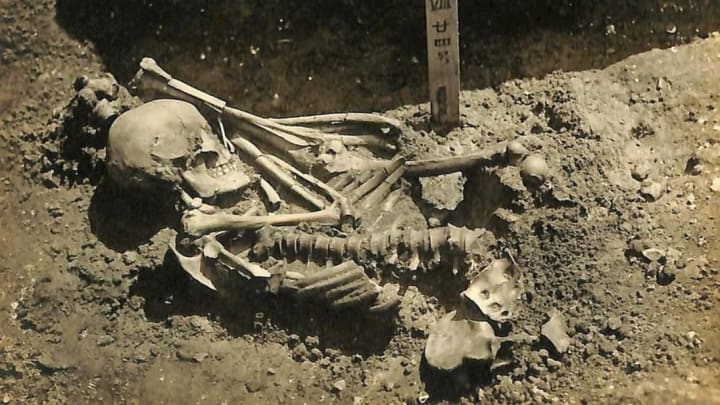While conducting a study on prehistoric person-to-person violence, University of Oxford researchers J. Alyssa White and Rick Schulting studied remains from Japan’s Tsukumo site—an ancient burial ground for fishers, hunters, and gatherers near the Seto Inland Sea.
Among those remains, first excavated in the early 20th century and now housed at Kyoto University, was the partial skeleton of an adult male with around 790 bone gouges, fractures, and other traumatic lesions. Researchers believed he lived during the Jōmon period, roughly between 10,500 BCE and 300 BCE (though not all historians agree on those start and end dates). His injuries appeared to have been caused by metal weapons, but as Schulting told Haaretz, metal was not part of the Jōmon culture.
After deciding the man probably hadn’t been killed by a person or one of the area’s land predators, the researchers came up with another theory: shark attack. They enlisted George Burgess, director emeritus of the Florida Museum of Natural History’s Florida Program for Shark Research, to help evaluate the evidence. As Smithsonian reports, their process involved using CT scans to create a 3D map of the victim’s wounds. They also used radiocarbon dating to calculate that he may have died sometime between 1370 BCE and 1010 BCE.
Their study, published in the Journal of Archaeological Science: Reports, suggests that the man was indeed battered by a shark—making this the earliest known shark attack in history. Before now, the oldest record of a shark attack was from around 1000 CE. As for what kind of shark was behind the assault, researchers suspect either a great white shark or a tiger shark.
They have some ideas about the circumstances of the attack, too. They think the man was alive when the shark targeted him, partially because his left hand is missing—suggesting he tried to defend himself. He may have been fishing with companions, which would help explain how most of his remains got salvaged and buried; they may have even been shark fishing, though it’s also possible that sharks had arrived on the scene after smelling other fishes’ blood.
While we’ll almost certainly never be able to confirm those details, the discovery of such an ancient shark attack is significant enough on its own.
“Shark attacks were and are extremely rare. There are on average about [10 fatalities] recorded a year in recent times, with a human population much larger than that of 3000 years ago,” Schulting told Haaretz. “So the Tsukumo individual is very unusual (and one might add he was very unlucky).”
[h/t Smithsonian]
